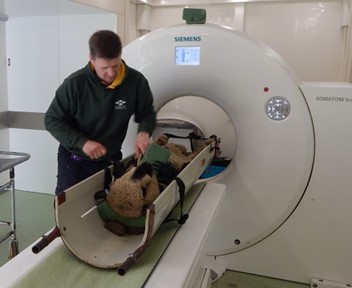For more information on new CT traits for sheep, read the 2018 factsheet here
New carcase EBVs for ram breeders
The ability to measure other economically valuable traits from existing CT images can add further value to the CT scanning process and enables breeders to select sheep that excel in other areas, for example :
Variation in spine traits of sheep have been studied at SRUC using topogram images that are routinely collected during CT scanning (Donaldson, 2015) and marked variation in spine traits were apparent within different sheep breeds and crosses, e.g. the Texel breed was found to have a within-breed range for thoracolumbar vertebrae number of 17 to 21 (the majority possessing 19).
Information on tissue densities collected during the CT scanning process also provide good estimates of intramuscular fat (IMF) in the loin of Texel sheep (R2>0.65) and prediction equations developed in this work were shown to work in different breeds, providing an objective proxy trait to predict meat eating quality in live animals (Clelland, 2015).
With greater access to these novel CT derived measurements in mind, AHDB Beef and Lamb have agreed to fund a team at SRUC to develop new Estimated Breeding Values (E BVs) for the following traits.
- Vertebrae number and spine length (in both the thoracic and lumber regions)
- CT-predicted intramuscular fat (IMF)
- Eye muscle area across the loin
The research will calculate heritability values for each traits, determine their genetic relationship to existing traits and assess the impact of their inclusion in current breeding programmes.
Who benefits?
This work has the potential to benefit everyone in the supply chain. Consumers will benefit from lamb with better eating quality, that has a greater yield of meat in the most desirable areas and is capable of being produced at lower cost. Processors and retailers have access to genetic solutions to help secure the supply of lambs that more closely meet their specifications and ensure greater consistency in both the quality and quantity of lamb supplied.
Importantly, Signet recorded ram breeders will benefit from the ability to promote breeding lines uniquely selected for these new characteristics traits, creating a unique selling point for commercial producers wanting longer, better fleshed or more productive progeny.
When will results be available?
The research has already started and the project will make EBVs routinely available towards the end of 2017.
How can I get involved?
The SRUC CT scanning unit provide a commercial CT scanning and measurement service for Signet clients at a series of agreed locations. In 2016 a new mobile CT scanner was purchased, giving greatly flexibility to users.
It is hoped that the combination of a new CT scanner and the promise of new CT derived EBVs will result in greater levels of CT scanning in the coming year – so book early. For more information on CT scanning, contact Kirsty McLean Tel: 0131 535 3250 Email: [email protected]
References
Clelland, N., Bunger, L., McLean, K.A., Conington, J., Maltin, C.A., Knott, S., & Lambe, N.R. 2015. Prediction of intramuscular fat levels in Texel lamb loins using X-ray computed tomography scanning. Meat Science, 98, (2) 263-271
Donaldson, C.L., Lambe, N.R., Maltin, C.A., Knott, S., & Bunger, L. 2013. Between and within breed variations of spine characteristics in sheep. Journal of Animal Science, 91, 995-1004
 For 20 years Computed Tomography (CT) scanning has been used to assess the body composition of sheep, with CT derived information now routinely used within the terminal sire breeding evaluations delivered by Signet Breeding Services. Over 10,000 ram lambs have been CT scanned in this time and the use of elite CT scanned sires for breeding purposes has greatly increased rates of genetic gain for carcase composition and related traits.
For 20 years Computed Tomography (CT) scanning has been used to assess the body composition of sheep, with CT derived information now routinely used within the terminal sire breeding evaluations delivered by Signet Breeding Services. Over 10,000 ram lambs have been CT scanned in this time and the use of elite CT scanned sires for breeding purposes has greatly increased rates of genetic gain for carcase composition and related traits.